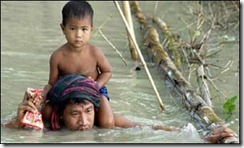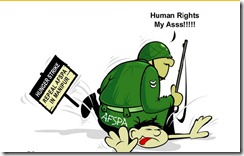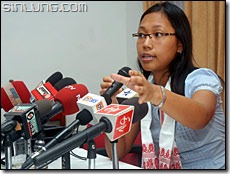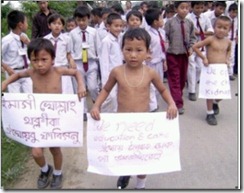Bharat (aka India) is bursting at the seams. The Nagas want complete independence from Delhi, and their aspirations of sovereignty and nationhood is in direct contradiction with the hegemony of the Indian Union which chooses to impose Delhi’s versions of a strong center.
The discussion of the fraying Union is anathema to most Bharatis–who are weaned on Bollywood version of history. Even though the Bharati press is full of stories the try to show them the reality of Bharat. However the majority of Bharatis gloss over the pages, and ignore the reality around them.
Engulfed in a sea of penury, Bharatis don’t realize that they are a millstone on South Asia–shackling the entire region into poverty–because of its obsession with regional hegemony and international stature. Even though 75% of the people of Delhi live in abject poverty–the country continues to spend billions on mortar and steel–and continues to waste money on building legacy systems to ward off ghosts and spirits. Delhi has been unable to comprehend the reality of a Nuclear world–and cannot understand “Mutually Assured Destruction” (MAD).
Bharat continues to fool itself by dreaming up “Cold Start Strategies”. It continues to ignore the internal cavities which prevent it from achieving its global goals.
There as as many insurgencies in Bharat as there are states. The Sub nationalities seek more than fifty states wanting varying degrees of freedom and independence from Delhi. Kashmir and Assam want nothing to do with Delhi. Maharashtra wants to impose Ram Rajha in its territory, and Gujerat is content with murdering more than 3000 Muslims and keeping 300,000 out of the state. Nagaland like Assam also wants complete independence from Delhi.
- The story of Nagaland is about being doubly colonized by the British and then by Bharat.
- After the British colonial withdrawal from Asia, Bharat occupied western Nagaland starting from the early 1950s.
- Burma followed suit and occupied eastern Nagaland.
- The Naga nationalists are convinced that they simply recovered their independence with the transfer of power in August 1947.
- The Nagas are thus seeking only a de jure recognition of that de facto reality of their independence given to them in 1947.
- The Union government sent the Indian Army in 1955 and occupied the state.
- Delhi forced an accord on July 1960 and finally extinguished the state in 1963
- The Nagas believe that the Nine-Point Agreement of June 1947 and the Shillong Accord of November 1975 consecrated their independence.
- The similarities of the Naga situation resembles the United Liberation Front of Asom in Assam are striking.
M. S. Prabhakara has written a prodigious article in The Hindu where Prabhakara describes the competing goals of the Nagas and those in power in Delhi.
The issues raised by the Naga nationalists are so complex that the talks between them and the Centre end in an impasse, only to be resumed at another time, another venue.
One has lost count but the present round of talks between the Centre and the National Socialist Council of Nagaland led by Isak Swu and Thuingaleng Muivah (NSCN-IM) must be the 66th or 67th, not taking into account the informal contacts that began way back in 1967. Perhaps not even during the momentous negotiations for transfer of power that led to the emergence of India and Pakistan as two sovereign nation-states were so many rounds of talks held.
This is not surprising. The issues raised by the Naga nationalists, rooted in their conviction that the Naga people simply recovered their independence with the transfer of power in August 1947 and are now seeking only a de jure recognition of that de facto reality, are so complex that some of the earlier parleys too — dating back to the days before India formally attained independence, from the Nine-Point Agreement of June 1947 to the Shillong Accord of November 1975 — were equally prolonged. However, while the Centre seems to have become adept at stonewalling demands during these negotiations, the Naga nationalists who, above all, want a solution, are left floundering.
The Shillong Accord that was supposed to have brought peace to Nagaland marked the beginning of divisions within the Naga nationalist movement, reflecting the divide in Naga society. However, the emergence of the NSCN in January 1980 was no less divisive, leading eight years later to another split, this time in the NSCN, resulting in the formation of the faction that views itself as the legitimate standard-bearer of Naga nationalism. It is using the initials of its principal office-bearers to distinguish itself from the other faction, NSCN-K (for Khaplang) — a tribute, indeed, to the factionalism of despised India’s mainstream political culture. Nor has the emergence of professedly militant and uncompromising, and contending, Naga nationalist factions meant the total political demise of the Phizoist Naga Nationalist Council. The result is that though the NSCN-IM claims with some legitimacy and the media too, even more than the Government of India, project the organisation as the structure with which an agreement has to be sealed for a “lasting peace in Nagaland,” there are several other actors who cannot be ignored.
First, there is the State government which, irrespective of its political persuasion, has always been in a symbiotic relationship with militant Naga nationalism of every complexion and persuasion. Then, there is the NSCN-K, with which too the GOI has a ceasefire agreement and is holding talks, though with less visibility. Of late, the NNC under the daughter of A.Z. Phizo has been demanding that it also be heard for a “lasting peace.”
The similarities to the situation obtaining with the United Liberation Front of Asom in Assam are striking. Any prospective talks between the GOI and the ULFA will necessarily include, irrespective of the outfit’s claims that it is the sole representative of Assamese nationalist aspirations, the real and constructed clones of the ULFA claiming the same legitimacy, as well as the State government.
Formally, there is a ceasefire agreement between the GOI and both NSCN factions. Negotiations for “a lasting peace in Nagaland” are also on with both factions, each of which claims it is the “sole representative” of the Naga nationalist aspirations. This fiction has given tremendous leeway to the GOI while tying the other side in knots.
This was evident in the prolonged talks held in New Delhi over several weeks in early 2005, when Mr. Muivah gave vent to both his hopes and frustrations over the seemingly never ending negotiations in his April 2005 interview on the Hard Talk programme of the BBC. Indeed, even before that interview, he seemed quite reconciled to and even ready for the collapse of the peace process — ready to “walk away.” Addressing the Naga People’s Consultative Conference (January 20-21, 2005) in ‘Hebron,’ headquarters of the Government of the People’s Republic of Nagalim (GPRN) near Dimapur, Mr. Muivah said the NSCN-IM would never compromise on its “core demands:” Naga sovereignty and the integration of the Naga-inhabited areas at present outside Nagaland into one territorial unit. Bhangile bhangibo (“if the talks break down, so be it”), he said, using the expressive Assamese idiom to communicate to a predominantly Nagaland-based audience whose lingua franca is a form of Assamese.
National sovereignty and the territorial imperative: these are the cutting edges of Naga nationalism. They are also the very essence of Indian nationalism, the bottom line on which no political formation can even appear to compromise. There is the even more problematic issue of Manipuri nationalism with a political programme of attaining a sovereign Manipur. The political map of ‘southern Nagalim’ includes four districts of Manipur: Senapati, Ukhrul, Tamenglong and Chandel. It is true that Naga insurgency derived much support from these areas in its early years. However, such is not the case now. Half-a-century down the line, the very Naga character of a once totally homogenous Ukhrul district has changed. The demographic changes in other areas claimed for ‘Southern Nagalim’ are even more far-reaching. They are also, like all demographic changes, irreversible. This probably explains the efforts of the NSCN-IM to mobilise public opinion in Ukhrul and Senapati districts in its support.
Even a trade-off between territoriality and sovereignty as a special case applicable only to the Naga nationalist struggle, retaining the substance of one and a compromise on the other, is not possible. The maximum concession the GOI is prepared to make is an unspecified assurance of “greater autonomy.” Both sides know this. And yet every round of talks so far has ended in a stalemate or impasse or deadlock, only to be resumed at another time, perhaps in another venue.
The fact is that despite its frustrations and threats of “walking away,” the NSCN-IM, no less than other Naga nationalist organisations, simply cannot afford to do so. Walking away would only mean walking away into oblivion. While the structures of the state and the government represented by ‘India’ may be corrupt, a mixed bag as in every other component of the Indian state, the people of the State have had uninterrupted peace. The dramatic changes that began in the 1990s and their seamy underbelly, which are now a feature not merely of urban India but also evident in small towns and villages, have not bypassed the Naga-inhabited areas. Nagaland and the Nagas may be terra incognita and persona incognita to much of the rest of India; but the Naga people have discovered India in massive numbers.
The NSCN-IM, too, has made many gains. It runs what amounts to a parallel government in the State, collects taxes, and sometimes dispenses justice as it sees fit. When in February last year, a popular non-Naga official working in Ukhrul was killed apparently by persons linked to the NSCN-IM, the arrest of one of the suspects was ‘facilitated’ by the NSCN-IM. Ukhrul at the height of the Naga insurgency was virtually dead by dusk; now shops, some of them owned and run by non-Nagas, are open late into the night. This correspondent was recently able to send an e-mail and speak to a friend in Johannesburg well past 10 p.m. from a cybercafé in Ukhrul. Life in Dimapur in Nagaland, only city where the Inner Line regulations apply and has consequently become an “open city,” is now more orderly, secure. These are not small gains.
The other side of peace is the spread and consolidation of the presence of the armed forces. Two corps, 3 and 4, of the armed forces are now headquartered in the northeast — in Tezpur and Dimapur. There is no need to press the point, or press the implications of such a massive presence of the armed forces for any attempt to resurrect insurgency. Unlike till late into the 1990s, the armed forces are now well equipped with the most sophisticated weapons. They are familiar with the region’s social and political landscape, including those represented by the powerful and resourceful NGO sector. They are conversant with the theories and practice of insurgency and counter-insurgency as well as theories of development as a tactic to counter insurgency.
So, talk the two sides will, talk they must, though a satisfactory convergence of the stands taken by them is nowhere in sight.
via the dawn Pakistan
 Lady Gaga is so popular that she belongs to a club of one--herself.
Lady Gaga is so popular that she belongs to a club of one--herself.












